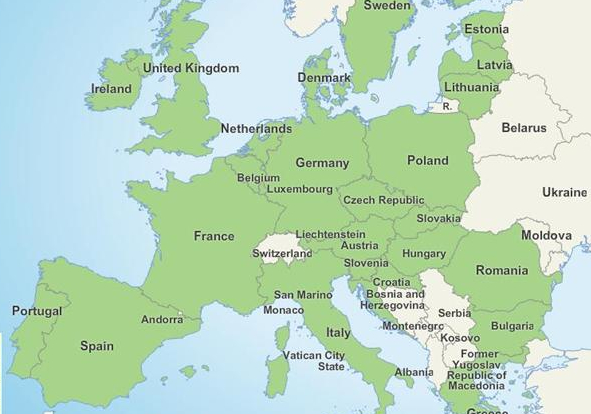On Sunday I will be leaving the English summer to drive across Europe to Romania. I shall be leaving my home in the Buckinghamshire countryside:

for 10,000 kilometres of the open road
I shall be avoiding those staple seasonal pleasures of the English bourgeoisie – Royal Ascot, Glyndebourne Opera, Henley Regatta and the Wimbledon tournament – and what Waitrose calls ‘the fabulous flavours of summer: Jersey Royals, British strawberries and asparagus’, for the culture and cuisine of what we used to call ‘the continent’. One of the election pledges of the victorious Conservatives this month was for a referendum which will give little Englanders the chance to turn their back on the continent and leave the European Union. There is little evidence of enthusiasm for this in Scotland, Ireland or Wales, but this isolationist impulse could speed the end of the union. Insofar that such decisions are often made through ignorance, it seemed a good time to remind myself of what Europe has to offer.
Over the next few weeks, I shall be travelling through Belgium, the Netherlands, Germany, Austria, Croatia and Serbia to Romania, then returning via Montenegro and the Dalmatian coast through Slovenia, Italy, Switzerland, Luxembourg and France. With the UK, that includes eleven of the EU’s 28 member states and three which are not. They are all countries I have visited before, and the trip should provide me with a good snapshot of the collective values at the central core of the European Union, which I intend to share through this blog.
But this is more than a political exercise for me. It retraces a journey I took once before, in the summer of 1968, when I had just left school. Already bitten by the travel bug, and about to study medieval history at Oxford, I combined these two enthusiasms in a mission to visit the painted monasteries of Moldavia. I had been alerted to the existence of these extraordinary buildings by an article in the Royal Geographical Society magazine, the Geographical, to which my grandmother had bought me a subscription. This feature explained how this area enjoyed an unchanged peasant culture, where eighty per cent still worked on the land, and the monasteries were supported by the communist state. I decided to hitch-hike there and left my home town of Salisbury with a passport and £50 in my pocket.
I have recently met the man whose article inspired me, Clive Barda, whose first professional assignment this was. Now internationally renowned as the finest of photographers working in the classical music field, he recalls what a powerful impression the people and places of Moldavia made. He was surprised to find his early work had had such a lasting impact on a reader, but he was not to have known that while I was staying in one monastery, just three miles from the Ukrainean border, the Soviets invaded Czechoslovakia to put down the Prague Spring. The then young President Ceausescu – yet to go mad – made the finest speech of his career, defying the Soviets to try the same on a Romania he threatened would fight to the last drop of blood to protect its sovereignty. Troop trains arrived in the area, full of soldiers younger than me carrying rifles older than me. This may well have been no more than political grandstanding, but it was thrilling to find oneself caught up in history like this, and it was undoubtedly instrumental in driving me towards a career in broadcast journalism and documentary film-making.
Now retired, I want to see how much has changed in 47 years. Despite joining the EU in 2007, Romania is the member state with the largest number of people still working on the land, some 25 per cent of the population. And despite UKIP fears of the UK being swamped by Romanian migrants last year, only just over 100,000 are working in Britain, of the 1.9 million EU nationals currently enjoying the freedom to work here. I shall also be spending some time in the EU’s latest accession state, Croatia, with Slovenia the first part of the Socialist Federal Republic of Yugoslavia to secede and help precipitate the ugly Balkan wars of the 1990s. Neither Romania nor Croatia are part of the eurozone, so that’s something else they share with the UK. It will be interesting to see how far the currently buoyant pound gets me in Europe today.
That £50 then, earned doing holiday jobs, would be worth over £800 today, and it kept me on the road for some ten weeks, albeit with exceptional hospitality in Eastern Europe. In 1968 I arrived in Romania within a week, only to find hitch-hiking harder there, since very few people had cars! This time, I am still travelling alone but will be driving my old Mercedes, which already has 115,000 miles on the clock but, with new tyres, is good for many more.
In 1968, a friend and I bunked off school to hitch-hike to Epsom for that year’s Derby. It’s a famously festive day out for Londoners, with the commoners turning the Hill at the centre of the racecourse into a colourful carnival. So I have decided that the one classic English event I will make is this year’s Derby, before departing for Dover the next morning. However, I will admit that I shall not be camping on the Hill, but poncing about like an over-stuffed penguin in the Queen’s Stand. Such indulgence is uniquely English and will no doubt survive the UK’s threatened withdrawal from Europe, so it will help frame my odyssey.






PETER
Today I was delighted to catch up with your blog and check on your progress and relieved that it seems you remain accident free. Just remember to pick up your sunglasses when stationary not driving!
We will be monitoring your trip and hope that all goes well.
Jerry
LikeLike